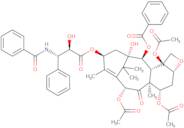7-Acetyl paclitaxel
CAS: 92950-39-5
Rif. 3D-FA17037
| 1mg | Fuori produzione | ||
| 2mg | Fuori produzione | ||
| 5mg | Fuori produzione | ||
| 10mg | Fuori produzione | ||
| 25mg | Fuori produzione |
Informazioni sul prodotto
- 7-Acetyltaxol(a-R,b-S)-b-(Benzoylamino)-a-hydroxy-benzenepropanoic acid (2aR,4S,4aS,6R,9S,11S,12S,12aR,12bS)-4,6,12b-tris(acetyloxy )-12-(benzoyloxy)-2a,3,4,4a,5,6,9,10,11,12,12a,12b-dodecahydro-11-hydroxy-4a,8,13,13-tetramethyl-5-oxo-7,11-methano-1H
- benzenepropanoic acid, beta-(benzoylamino)-alpha-hydroxy-, (2aR,4S,4aS,6R,9S,11S,12S,12aR,12bS)-4,6,12b-tris(acetyloxy)-12-(benzoyloxy)-2a,3,4,4a,5,6,9,10,11,12,12a,12b-dodecahydro-11-hydroxy-4a,8,13,13-tetramethyl-5-oxo-7,11-methano-1H-cyclodeca[3,4]benz[1,2-b]oxet-9-yl ester, (alphaR,betaS)-
Paclitaxel is a drug that is used to treat various cancers. Paclitaxel is a natural product obtained from the yew tree and contains two acetyl groups. The drug can be stabilized with an organic solvent, such as diethylether or benzene, which are often impurities. Paclitaxel has been shown to be effective against drug-resistant cells in vitro and in vivo. The efficacy of paclitaxel for the treatment of cancer depends on its modifications and on the phenotype of the tumor cells. Paclitaxel can be modified by acetylation, methylation, or other reactions to improve its solubility in water and its stability in plasma. Multidrug resistance-associated proteins (MRPs) play a major role in the extrusion of paclitaxel out of cancerous cells.





